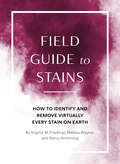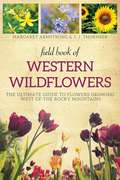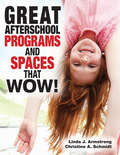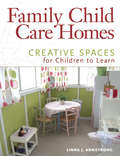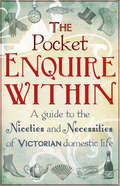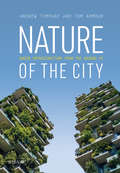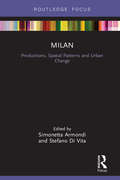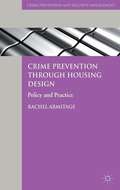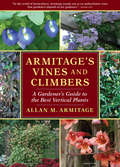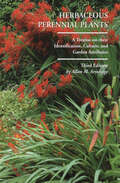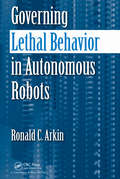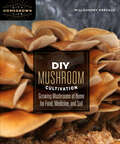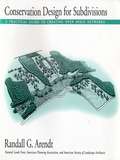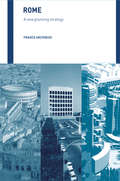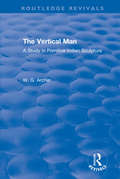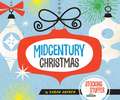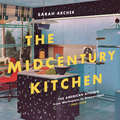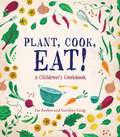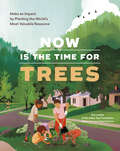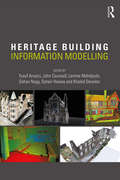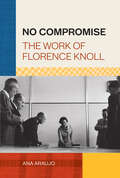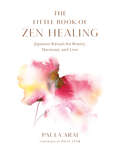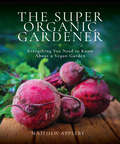- Table View
- List View
Field Guide to Stains: How to Identify and Remove Virtually Every Stain on Earth (Field Guide)
by Nancy Armstrong Melissa Wagner Virginia M. FriedmanAt last, a field guide to identifying and doing battle with more than 100 stains, from tomato juice to tar, from avocado to urine! Field Guide to Stains is divided into handy sections for easy access to information when time is of the essence: Fruits and Vegetables, Meat and Protein, Household Items, Garage and Yard, and more. Readers will learn more than just removal techniques--details include general descriptions and likely seasons, times, and areas of occurrence. Did you know that a yogurt stain is more likely to occur in January (when New Year's resolutions demand more healthy eating), and that correction fluid stains are more prevalent in April (when the pressure to complete your taxes on time is at a high)? Includes more than 100 full-color photographs of stains, each one cross-referenced to its description and step-by-step removal advice. Quick-reference icons guide the reader to the most essential information in each entry. This guide has a sturdy, stain-proof exterior--making it a necessity for every cubicle, glove compartment, and college dorm. Field Guide to Stains is a must-have for everyone about to venture out into the wild, to the kitchen, or to a night on the town!
Field Book of Western Wild Flowers: The Ultimate Guide to Flowers Growing West of the Rocky Mountains
by Margaret ArmstrongMargaret Armstrong, a prolific book cover designer and illustrator, spent a few years traveling around the western United States at the beginning of the twentieth century, and in 1911 she was one of the first women to descend to the floor of the Grand Canyon. There she discovered some new flower species and began writing and illustrating the exquisite and thorough Field Book of Western Wildflowers.This was the first comprehensive handbook to supply detailed information about the plethora of flowers growing in the western United States and includes detailed information on seventy-five plant families, like water-plantain, lily, buttercup, poppy, mustard, hydrangea, plum, rose, cactus, wintergreen, figwort, and valerian families, and many others.Armstrong includes information on key characteristics of each species, including height, leaf and petal features, colors, where each flower can most likely be found, ideal conditions they flourish in, and much more.
Great Afterschool Programs and Spaces That Wow!
by Linda J. Armstrong Christine A SchmidtDoes your afterschool program have the WOW factor?Create a high quality school-age program that is exciting, inviting, and reflects the interests, abilities, and needs of the children. Whether your program operates before or after school, on non-school days, during the summer, or overnight, you can create a dynamic environment where everyone will enjoy spending time.This book is filled with hundreds of ideas-from setting up a quiet reading nook to tackling clutter-reflecting the authors' years of experience and hundreds of visits to a variety of school-age programs. It takes you through all of the considerations that affect your program and then lays out a process to help you improve the three dimensions of a school-age environment.Temporal: Establish schedules, routines, rules, and learning opportunities to meet children's needsInterpersonal: Facilitate the relationships and social interactions of children, staff, families, and the greater communityPhysical: Create sensory-rich indoor and outdoor spacesLinda J. Armstrong and Christine A. Schmidt are experienced educational consultants who serve children and youth programs throughout the United States.
Family Child Care Homes
by Linda J. ArmstrongCreate a warm and inviting place where children feel at home.Discover the many ways your home can provide comfortable places where children love to learn and love to be. Filled with no- and low-cost ideas, this book demonstrates many unique and practical possibilities for your home's indoor and outdoor spaces. Chapters are packed with colorful photographs and provide examples and tips for designing learning zones, selecting items, organizing materials, and more. Checklists, resources, and questions are included to help you evaluate your setting, implement changes, and create a place that feels like a second home to the children in your care.
The Pocket Enquire Within: A guide to the niceties and necessities of Victorian domestic life
by George ArmstrongWhat is the correct way to carve a partridge?How should leeches be applied?How can egg whites be used to repair broken china?First published in 1856, Enquire Within rapidly became the indispensable guide to Victorian domestic life. Packed with words of wisdom and pithy advice, it covered everything from entertaining and etiquette to household management, and took in considered discussion of such arcane matters as how singing might prevent consumption, and which ointments will remove freckles, not to mention why chess should on no account ever be played at a ball.This new, charmingly illustrated pocket-sized edition contains a selection of hints and tips that not only provide a fascinating insight into the day-to-day life of Victorian Britain, but also, in places, reveal timeless wisdom that we would do well to heed today.
Nature of the City: Green Infrastructure from the Ground Up
by Tom Armour Andrew TempanyThis is a practical guide to delivering green infrastructure from the ground up and bringing nature in to the built environment. Exploring the process of delivery through an array of design approaches and case studies, it demystifies the concept and provides the tools for practical implementation - highlighting the challenges and opportunities on both small and large projects.
Milan: Productions, Spatial Patterns and Urban Change (Built Environment City Studies)
by Simonetta Armondi Stefano Di VitaAs a main urban centre of one of the most dynamic European regions, Milan is a key location from which to study narratives of innovations and contemporary productions – old and new manufacturing, tertiary and consumptive sectors, creative and cultural economy – and investigate their influence both on spatial patterns and urban policy agenda. Accordingly, this book explores the contentious geographies of innovation, productions and working spaces, both empirically and theoretically in a city that, since the beginning of the 2000s, has been involved in a process of urban change, with relevant spatial and socio-economic effects, within an increasingly turbulent world economy. Through this analysis, the book provides an insight into the complexity of contemporary urban phenomena beyond a traditional metropolitan lens, highlighting issues such as rescaling, urban decentralization and recentralization, extensive urban transformation and shrinkage and molecular urban regeneration. This book is a valuable resource for academics, researchers and scholars focusing on Urban Studies such as Urban Policy, Urban Planning, Urban Geography, Urban Economy and Urban Sociology.
Crime Prevention through Housing Design
by Rachel ArmitageThis book presents a comprehensive review of the impact of residential design on crime focusing upon research, policy and practice both in the UK and internationally, appealing to both academics and practitioners within the fields of crime prevention, urban planning and architecture.
Armitage's Vines and Climbers: A Gardener's Guide to the Best Vertical Plants
by Allan M. Armitage“Climbing plants are hugely underrated—this book with its lively expression of deep knowledge should encourage everyone to grow more of them.” —Noël Kingsbury Climbing plants constitute a huge, and largely untapped, resource for today’s gardeners. Because their habit of growth is primarily vertical, they can be used for utilitarian as well as ornamental purposes like providing privacy, or screening eyesores. In this comprehensive reference, renowned horticulturist Allan Armitage selects and profiles the most useful and attractive climbing plants for a wide range of sites and conditions, from well-known favourites like clematis, morning glories, and wisteria to more unusual plants like Dutchman’s pipe, passion flowers, and the tropical mandevillas. Each profile includes a general description (enlivened by Armitage’s trademark wry humour) along with the plant’s hardiness, plant family, best method of propagation, method of climbing, and etymology of botanical and common names.“Climbing plants are hugely underrated—this book with its lively expression of deep knowledge should encourage everyone to grow more of them.” —Noël Kingsbury
Herbaceous Perennial Plants: A Treatise on their Identification, Culture, and Garden Attributes
by Allan ArmitageThe third edition of the comprehensive—and entertaining—gardening reference by the master horticulturalist.This is the long-awaited third edition of Allan Armitage’s masterpiece on garden perennials. Armitage’s extensive traveling, teaching, and trialing experiences provide a depth of understanding of the best ornamental perennials for North American gardens unparalleled by any other garden writer. One of the most definitive and conclusive books written about perennials, the first edition was designated as one of the best seventy-five books written in the last seventy-five years by the American Horticulture Society. Now the third edition of “The Big Perennial Book” (as it is fondly referred to by many practitioners) describes 3,600 species in 1224 pages. More than three hundred color photos complement detailed text filled with the author’s pointed observations of plant performance, cultivar selection, and current taxonomy. In addition, his trademark wit and passion are both in abundance, making reading as pleasurable as it is informative.
Governing Lethal Behavior in Autonomous Robots
by Ronald ArkinExpounding on the results of the author's work with the US Army Research Office, DARPA, the Office of Naval Research, and various defense industry contractors, Governing Lethal Behavior in Autonomous Robots explores how to produce an "artificial conscience" in a new class of robots, humane-oids, which are robots that can potentially perform more et
DIY Mushroom Cultivation: Growing Mushrooms at Home for Food, Medicine, and Soil (Homegrown City Life)
by Willoughby Arevalo"Offering clear and comprehensive instructions for low-tech growing for a range of budgets, interests, and scales, this book offers practical inspiration and a sense that "hey, I can do this!" –— DANIELLE STEVENSON, owner, DIY FungiDIY Mushroom Cultivation is full of proven, reliable, low-cost techniques for home-scale cultivation that eliminate the need for a clean-air lab space to grow various mushrooms and their mycelium.Beautiful full-color photos and step-by-step instructions accompany a foundation of mushroom biology and ecology to support a holistic understanding of the practice. Growing techniques are applicable year-round, for any space from house to apartment, and for any climate, budget, or goal. Techniques include:Setting up a home growing spaceInexpensive, simple DIY equipmentCulture creation from mushroom tissue or sporesGrowing and using liquid cultures and grain spawnGrowing mushrooms on waste streams Indoor fruitingOutdoor mushroom gardens and logsHarvesting, processing, tinctures, and cooking.Whether you hunt mushrooms or dream about growing and working with them but feel constrained by a small living space, DIY Mushroom Cultivation is the ideal guide for getting started in the fascinating and delicious world of fungiculture.
Conservation Design for Subdivisions: A Practical Guide To Creating Open Space Networks
by Randall G. ArendtIn most communities, land use regulations are based on a limited model that allows for only one end result: the production of more and more suburbia, composed of endless subdivisions and shopping centers, that ultimately covers every bit of countryside with "improvements." Fortunately, sensible alternatives to this approach do exist, and methods of developing land while at the same time conserving natural areas are available. In Conservation Design for Subdivisions, Randall G. Arendt explores better ways of designing new residential developments than we have typically seen in our communities. He presents a practical handbook for residential developers, site designers, local officials, and landowners that explains how to implement new ideas about land-use planning and environmental protection. Abundantly illustrated with site plans (many of them in color), floor plans, photographs, and renditions of houses and landscapes, it describes a series of simple and straightforward techniques that allows for land-conserving development. The author proposes a step-by-step approach to conserving natural areas by rearranging density on each development parcel as it is being planned so that only half (or less) of the buildable land is turned into houselots and streets. Homes are built in a less land-consumptive manner that allows the balance of property to be permanently protected and added to an interconnected network of green spaces and green corridors. Included in the volume are model zoning and subdivision ordinance provisions that can help citizens and local officials implement these innovative design ideas.
Envisioning Better Communities: Seeing More Options, Making Wiser Choices
by Randall ArendtThe author's work has shaped a generation of planners, designers, and landscape architects. In this book, the author brings his insights to a broader public, with a profusely illustrated demonstration of how local officials, planning commissioners, and everyday citizens can work to make their communities more attractive, more habitable, and more sustainable. Despite the widespread acceptance of good design and planning principles throughout the professions, too many of our towns and rural areas remain needlessly ugly and inefficient. In side by side comparisons of similar places and kinds of buildings, the author shows that we need not live amid sprawling, characterless visual blight. Simple design choices and effective municipal decisions can have tremendous impacts on the quality of our communities. Written in the author's well-known clear, accessible, nontechnical style, this book creates a sense of hope for those who face the everyday challenges of working with developers and landowners to create places that make economic, environmental, and aesthetic sense. The author shows us that with diligence, thoughtfulness, and care, we can make our communities better in countless ways.
Rome: A New Planning Strategy
by Franco ArchibugiRome: A New Planning Strategy looks at the problems of a city over the last century and suggests a totally new planning strategy. The book examines the stages that have marked the increase of population and change in land use and analyses the masterplans used to try and control these evolving conditions. Using Rome as an extended case study, the book deals with the socio-economic effect of an absence of planning strategy during the recent growth of the city. The author presents the characters and features of a new masterplan based on his many years of experience in theoretical and practical planning.
The Vertical Man: A Study in Primitive Indian Sculpture (Routledge Revivals)
by W.G. ArcherOriginally published in 1947, The Vertical Man explores a form of Indian sculpture largely ignored in other studies, with a focus on two kinds of sculpture from the province of Bihar. The book provides detailed analysis of the formal characteristics of the sculpture and the influences of the myth, ritual, and context in which they were commissioned and made. It explains why the sculpture is regional and "why the styles are what they are". It is an original study which throws light on important subjects such as the relations of art and religion and of art and economics. The Vertical Man will appeal to those with an interest in art, specifically sculpture and the art of the Indian countryside.
Midcentury Christmas Stocking Stuffer Edition (Stocking Stuffer Edition)
by Sarah ArcherA celebration of (vintage) Christmas past Midcentury America was a wonderland of department stores, suburban cul-de-sacs, and Tupperware parties. At Christmastime, postwar America’s dreams and desires were on full display, from shopping mall Santas to shiny aluminum Christmas trees, from the Grinch to Charlie Brown’s beloved spindly Christmas tree. With more than 100 colorful illustrations and iconic designs, Sarah Archer celebrates the turning point of Christmas in America, when new technologies and unprecedented prosperity made anything seem possible. Midcentury Christmas is sure to be on everyone’s wish lists.
The Midcentury Kitchen: America's Favorite Room, From Workspace To Dreamscape, 1940s-1970s
by Sarah ArcherAn illustrated pop history from aqua to avocado, Westinghouse to Wonder Bread Nearly everyone alive today has experienced cozy, welcoming kitchens packed with conveniences that we now take for granted. Sarah Archer, in this delightful romp through a simpler time, shows us how the prosperity of the 1950s kicked off the technological and design ideals of today’s kitchen. In fact, while contemporary appliances might look a little different and work a little better than those of the 1950s, the midcentury kitchen has yet to be improved upon. During the optimistic consumerism of midcentury America when families were ready to put their newfound prosperity on display, companies from General Electric to Pyrex to Betty Crocker were there to usher them into a new era. Counter heights were standardized, appliances were designed in fashionable colors, and convenience foods took over families’ plates. With archival photographs, advertisements, magazine pages, and movie stills, The Midcentury Kitchen captures the spirit of an era—and a room—where anything seemed possible.
Plant, Cook, Eat!: A Children's Cookbook
by Joe Archer Caroline CraigFor beginners and green-thumbed foodies, this unusually all-inclusive garden-to-kitchen cookbook is part lesson in gardening and part collection of healthy, delicious, kid-friendly recipes.With vibrant photo-illustrations and clearly organized sections, discover how to plant seeds in patio containers, window boxes, or on an allotment; harvest fruits and vegetables; determine which plant parts are edible; spot pests in the garden; and use home-grown crops to cook everything from bean and bacon spaghetti to polenta chips to tomato, feta, and basil pizza."This effort offers budding young gardeners (and their adults) a comprehensive, hands-on guide to gardening and cooking" — Kirkus Reviews STARRED REVIEW
Now Is the Time for Trees: Make an Impact by Planting the Earth's Most Valuable Resource
by Arbor Day Foundation Dan Lambe&“Celebrates the power of trees to oxygenate the planet, purify water and air, lower city temperatures, provide habitat, nurture the soul, and provide essential food sources.&” —Booklist Trees and forests are the number one nature-based solution for reversing the negative effects of a changing climate. If ever there was a time to be planting trees, that time is now. Inspired by a collective sense of urgency, a global movement to plant trees is gaining momentum. To move the needle, we need to act on a massive scale and plant millions of trees today to have a measurable and lasting impact on billions of lives tomorrow. In Now Is the Time for Trees, the experts at the Arbor Day Foundation will inspire you to do your part by showing you everything you need to know to plant trees at home or in your community. From advice on choosing the right size and type of tree to tried-and-true tips for planting success, this book will help you plant a tree today and leave your own legacy of hope. Equal parts inspiration and advocacy, Now Is the Time for Trees is a rousing call for environmental action and a must-have book for nature lovers everywhere.
Heritage Building Information Modelling
by Yusuf Arayici John Counsell Lamine Mahdjoubi Gehan Ahmed Nagy Soheir Hawas Khaled DweidarBuilding Information Modelling (BIM) is being debated, tested and implemented wherever you look across the built environment sector. This book is about Heritage Building Information Modelling (HBIM), which necessarily differs from the commonplace applications of BIM to new construction. Where BIM is being used, the focus is still very much on design and construction. However, its use as an operational and management tool for existing buildings, particularly heritage buildings, is lagging behind. The first of its kind, this book aims to clearly define the scope for HBIM and present cutting-edge research findings alongside international case studies, before outlining challenges for the future of HBIM research and practice. After an extensive introduction to HBIM, the core themes of the book are arranged into four parts: Restoration philosophies in practice Data capture and visualisation for maintenance and repair Building performance Stakeholder engagement This book will be a key reference for built environment practitioners, researchers, academics and students engaged in BIM, HBIM, building energy modelling, building surveying, facilities management and heritage conservation more widely.
No Compromise: The Work of Florence Knoll
by Ana AraujoFlorence Knoll (1917–2019) was a leading force of modern design. She worked from 1945 to 1965 at Knoll Associates, first as business partner with her husband Hans Knoll, later as president after his death, and, finally, as design director. Her commissions became hallmarks of the modern era, including the Barcelona Chair by Mies van der Rohe, the Diamond Chair by Harry Bertoia, and the Platner Collection by Warren Platner. She created classics like the Parallel Bar Collection, still in production today.Knoll invented the visual language of the modern office through her groundbreaking interiors and the creation of the acclaimed "Knoll look," which remains a standard for interior design today. She reinvigorated the International Style through humanizing textiles, lighting, and accessories. Although Knoll's motto was "no compromise, ever," as a woman in a white, upper-middle-class, male-dominated environment, she often had to make accommodations to gain respect from her colleagues, clients, and collaborators. No Compromise looks at Knoll's extraordinary career in close-up, from her student days to her professional accomplishments.
The Little Book of Zen Healing: Japanese Rituals for Beauty, Harmony, and Love
by Paula AraiAccessible and adaptable Japanese Buddhist rituals to infuse your life with purpose, healing, and gratitude when you need it most.How do we make and sustain meaning amidst the messy conditions of daily life? Personalized rituals can help us blossom like lotuses right in the mud of the present. On a pilgrimage she began after her mother&’s death, author Paula Arai encountered numerous Japanese Buddhists who taught her the remarkable power of ritual to heal—practices you can adapt to your own cultural and personal circumstances. Applying principles of Zen practice, she offers stories and insights that illuminate how to nourish and reap a healing bounty of connection, joy, and compassion. Examples include how to: Relate to a late loved one as a &“personal Buddha&” who supports you Create a home altar to serve as a safe space to be vulnerable, face intense emotions, and experience a depth of warm gratitude that melts fear and anger Engage in daily tasks with attentiveness, intention, and creativity such that they become opportunities for body-mind integration Develop family rituals to celebrate relationship and mark transition Approach illness and grief with a purposeful sense of connection to life-and-death in its wholeness Like Marie Kondo's Shinto principles for decluttering, Paula Arai uses rituals influenced by Japanese Zen for personal and relation nourishment and spiritual healing.
The Super Organic Gardener: Everything You Need to Know About a Vegan Garden
by Matthew ApplebyIf you care about what you eat, you should care about how you grow it.Gardeners can demonstrate that by going beyond organics to veganics - growing without animal inputs - they are a driving force in saving the environment.This book gives you the tools to grow without harming the planet and animals, and explains why moving beyond organics towards super organic vegan gardening is the way to show you are genuinely concerned about environmental issues and the industrial commodification of living, sentient creatures.From advice about how to make and buy natural fertilisers and compost, to putting nutritional values on what you grow, and to how to cook it, and how to share your plot with wildlife, this book covers all the bases.The foreword is by RHS Chelsea Flower Show best in show winner Cleve West, who is a passionate vegan gardener. Vegan Organic Network and Garden Organic have backed the book too.
The Super Organic Gardener: Everything You Need to Know About a Vegan Garden
by Matthew ApplebyIf you care about what you eat, you should care about how you grow it.Gardeners can demonstrate that by going beyond organics to veganics - growing without animal inputs - they are a driving force in saving the environment.This book gives you the tools to grow without harming the planet and animals, and explains why moving beyond organics towards super organic vegan gardening is the way to show you are genuinely concerned about environmental issues and the industrial commodification of living, sentient creatures.From advice about how to make and buy natural fertilisers and compost, to putting nutritional values on what you grow, and to how to cook it, and how to share your plot with wildlife, this book covers all the bases.The foreword is by RHS Chelsea Flower Show best in show winner Cleve West, who is a passionate vegan gardener. Vegan Organic Network and Garden Organic have backed the book too.
